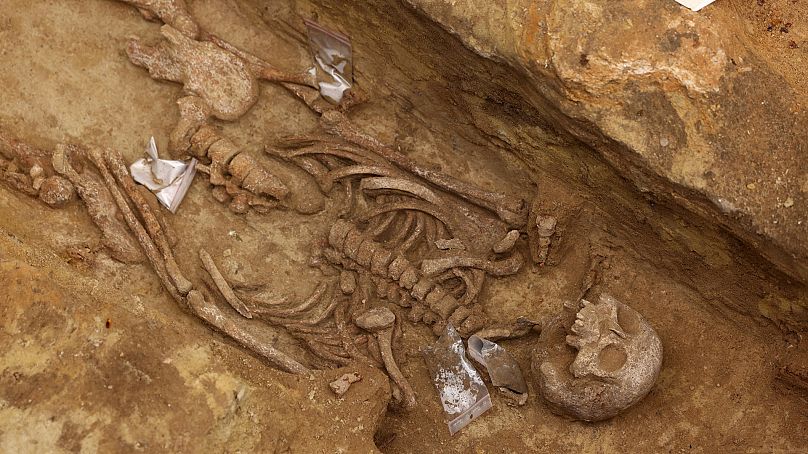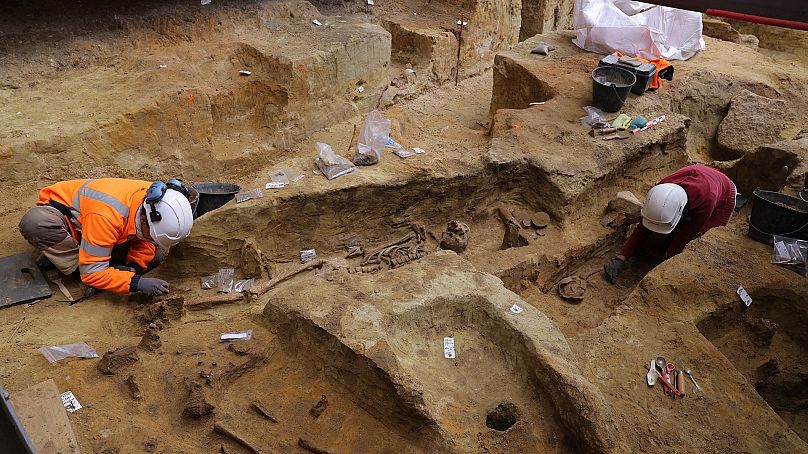The burial site could shed light on the little-known culture of Paris' precursor Lutetia, a Gallo-Roman town that existed nearly 2000 years ago.
For centuries, Parisians have been walking on top of thousands of years of history – from the catacombs to remnants of civilisations past.
Scientists have now unveiled the latest surprising discovery made just three metres beneath the well-beaten pavement in the heart of the French capital – 50 previously undisturbed graves found just a stone’s throw from a popular metro stop.
Somehow the necropolis had remained buried despite multiple construction projects over the years, as well as the construction of the Port-Royal station on the historic Left Bank in the 1970s.
It was finally uncovered this year, when plans for a new exit for the train station prompted an archaeological excavation. The discovery offers a rare glimpse into what life was like in the Roman town of Lutetia, which existed nearly 2,000 years ago where Paris now stands.
The story of a city lost in time
Camille Colonna, an anthropologist at France's National Institute of Preventive Archaeological Research (INRAP), told journalists that there were already "strong suspicions" the site was close to Lutetia's southern necropolis.
The "Saint Jacques" necropolis, the largest burial site in the Gallo-Roman town of Lutetia, was partially excavated in the 1800s. But only artefacts considered “precious” were taken from the graves, which means many skeletons and burial offerings were abandoned.
The site was not maintained, and over the years it became covered again and its exact location lost in time. This new section of the necropolis, which archaeologists began excavating in March, has never before been seen.
"No one has seen it since antiquity," said INRAP president Dominique Garcia.
Colonna said the team was able to date the burial site to the second century AD, due to a coin they found in one of the skeleton’s mouths.
Rituals, rites and offerings
The remains of the 50 men, women and children are believed to be Parisii, a Gallic people who lived in Lutetia when the fishing village was controlled by the Roman Empire. The city’s modern name was derived from these early inhabitants.
Their skeletons were buried in wooden coffins, which archaeologists were able to identify only by their metal nails. More than half of the bodies were buried with offerings, including ceramic jugs and goblets.
Sometimes a coin was placed in the coffin, or even in the mouth of the dead, to guarantee the soul’s safe passage to the underworld. The common practice was called Charon’s obol, named after Hades’ ferryman who would carry the souls of the dead across the river Styx in Greek mythology.
The French archaeologists also found personal effects like jewellery, hairpins, belts or shoes inside the graves. The bodies were buried fully clothed and sometimes with multiple pairs of shoes placed alongside them, which scientists were able to identify by the tiny nails used to secure the soles.
Colonna said the shoes were placed “either at the feet of the dead or next to them, like an offering.”
“We have one tomb with five pairs of shoes,” she added. “If they were placed flat, we can still see, by the nails, the shape of the shoe and almost even guess its size.”
Archaeologists also found a full skeleton of a pig and another small animal in a pit where animals were thought to have been sacrificed to the gods.
A full analysis begins
Unlike the last excavation of the Saint Jacques necropolis in the 1800s, this time the team has removed every object from the site and plans to analyse them all.
“This will allow us to understand the life of the Parisii through their funeral rites, as well as their health by studying their DNA,” Colonna said.
Some of the questions scientists hope to answer include how the necropolis evolved and spread out over the years, and what its organisation looked like. They also hope to analyse the ceramic containers to find out what was in them – like honey, oil or food.
Garcia said the finding was exciting because the ancient history of Paris is “generally not well known.” The unearthed graves therefore open “a window into the world of Paris during antiquity.”
INRAP says the necropolis is believed to spread out even further across the south of Paris. But those ancient secrets will remain buried, as new excavations can only take place if construction projects threaten to damage the sites.













